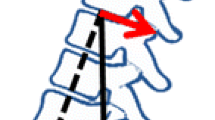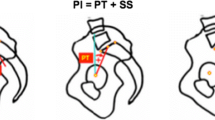Abstract
There is a wide variation in the regional parameters used to describe the spine and sacro-pelvis in children and adolescents. There is a slight tendency for thoracic kyphosis and lumbar lordosis to increase with age. Pelvic incidence and pelvic tilt also tend to increase during growth, while sacral slope remains relatively stable. Strong knowledge of the close relationships between adjacent anatomical regions of the spine and sacro-pelvis is the key when evaluating and interpreting sagittal spino-pelvic alignment. The scheme of correlations between adjacent regional parameters needs to be preserved in order to maintain a balanced posture. The net resultant from these relationships between adjacent anatomical regions is best represented by parameters of sagittal global balance. C7 plumbline tends to move backwards from childhood to adulthood, where it stabilizes or slightly moves forward secondary to degenerative changes. C7 plumbline in front of both hip axis and center of the upper sacral endplate occurs in 29% of subjects aged 3–10 years, 12% of subjects aged between 10 and 18 years, and 14% of subjects aged 18 years or older. Therefore, although most normal subjects stand with a C7 plumbline behind the hip axis, a C7 plumbline in front of both hip axis and sacrum can be seen in normal individuals. However, progressive forward displacement of C7 plumbline should raise a suspicion for the risk of developing spinal pathology.




Similar content being viewed by others
References
Kuntz C 4th, Shaffrey CI, Ondra SL, Durrani AA, Mummaneni PV, Levin LS, Pettigrew DB (2008) Spinal deformity: a new classification derived from neutral upright spinal alignment measurements in asymptomatic juvenile, adolescent, adult, and geriatric individuals. Neurosurgery 63:A25–A39
Voutsinas SA, MacEwen GD (1986) Sagittal profiles of the spine. Clin Orthop 210:235–242
Bernhardt M, Bridwell KH (1989) Segmental analysis of the sagittal plane alignment of the normal thoracic and lumbar spines and thoracolumbar junction. Spine 14:717–721
Boseker EH, Moe JH, Winter RB, Koop SE (2000) Determination of “normal” thoracic kyphosis: a roentgenographic study of 121 “normal” children. J Pediatr Orthop 20:796–798
Cil A, Yazici M, Uzumcugil A, Kandemir U, Alanay A, Alanay Y, Acaroglu RE, Surat A (2005) The evolution of sagittal segmental alignment of the spine during childhood. Spine 30:93–100
Mac-Thiong JM, Labelle H, Berthonnaud E, Betz RR, Roussouly P (2007) Sagittal spinopelvic balance in normal children and adolescents. Eur Spine J 16:227–234
Duval-Beaupère G, Schmidt C, Cosson P (1992) A barycentremetric study of the sagittal shape of spine and pelvis: the conditions required for an economic standing position. Ann Biomed Eng 20:451–462
Vedantam R, Lenke LG, Keeney JA, Bridwell KH (1998) Comparison of standing sagittal spinal alignment in asymptomatic adolescents and adults. Spine 23:211–215
Mac-Thiong JM, Berthonnaud E, Dimar JR 2nd, Betz RR, Labelle H (2004) Sagittal alignment of the spine and pelvis during growth. Spine 29:1642–1647
Descamps H, Commare-Nordmann MC, Marty C, Hecquet J, Duval-Beaupere G (1999) Modifications des angles pelviens, dont l’incidence, au cours de la croissance humaine. Biom Hum Anthropol 17:59–63
Mangione P, Gomez D, Senegas J (1997) Study of the course of the incidence angle during growth. Eur Spine J 6:163–167
Marty C, Boisaubert B, Descamps H, Montigny JP, Hecquet J, Legaye J, Duval-Beaupère G (2002) The sagittal anatomy of the sacrum among young adults, infants, and spondylolisthesis patients. Eur Spine J 11:119–125
Berthonnaud E, Dimnet J, Roussouly P, Labelle H (2005) Analysis of the sagittal balance of the spine and pelvis using shape and orientation parameters. J Spinal Disord Tech 18:40–47
Glassman SD, Bridwell K, Dimar JR, Horton W, Berven S, Schwab F (2005) The impact of positive sagittal balance in adult spinal deformity. Spine 30:2024–2029
Mac-Thiong JM, Transfeldt EE, Mehbod AA, Perra JH, Denis F, Garvey TA, Lonstein JE, Wu C, Dorman CW, Winter RB (2009) Can C7 plumbline and gravity line predict health related quality of life in adult scoliosis? Spine 34:E519–E527
Mac-Thiong JM, Wang Z, de Guise JA, Labelle H (2008) Postural model of sagittal spino-pelvic balance and its relevance for lumbosacral developmental spondylolisthesis. Spine 33:2316–2325
Jackson RP, McManus RP (1994) Radiographic analysis of sagittal plane alignment and balance in standing volunteers and patients volunteers and patients with low back pain matched for age, sex, and size. A prospective controlled clinical study. Spine 19:1611–1618
Roussouly P, Gollogly S, Noseda O, Berthonnaud E, Dimnet J (2006) The vertical projection of the sum of the ground reactive forces of a standing patient is not the same as the C7 plumb line. A radiographic study of the sagittal alignment of 153 asymptomatic volunteers. Spine 31:E320–E325
Mac-Thiong JM, Roussouly P, Berthonnaud E, Guigui P (2010) Sagittal parameters of global balance. Normative values from a prospective cohort of seven hundred nine white asymptomatic adults. Spine 22:E1193–E1198
Mac-Thiong J-M, Roussouly P, Berthonnaud É, Labelle H (2010) Global sagittal spinal balance: normative values from a prospective cohort of 715 asymptomatic adults and 646 asymptomatic children. In: Presented at the Scoliosis Research Society 45th annual meeting & combined course, Kyoto, Japan, September 21–24
Conflict of interest
None.
Author information
Authors and Affiliations
Corresponding author
Rights and permissions
About this article
Cite this article
Mac-Thiong, JM., Labelle, H. & Roussouly, P. Pediatric sagittal alignment. Eur Spine J 20 (Suppl 5), 586 (2011). https://doi.org/10.1007/s00586-011-1925-0
Received:
Accepted:
Published:
DOI: https://doi.org/10.1007/s00586-011-1925-0




